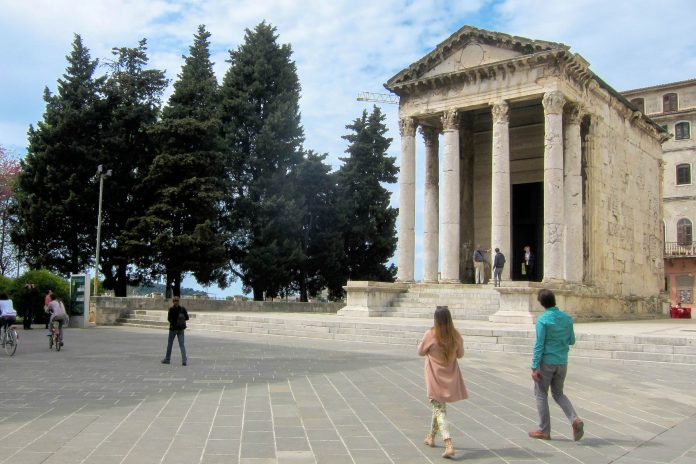In der schmucken Altstadt von Pula überwiegen zwischen netten Cafés und historischen Festungsanlagen die prachtvollen Bauten der römischen Antike, unter anderem eines der weltgrößten Amphitheater.
Das malerische Pula ist der größte Ort in Istrien. Er beeindruckt vor allem durch seine aufregende architektonische Mischung, die Römer, Byzantiner, Venezianer, Österreicher und Italiener im Lauf der Epochen hinterlassen haben.
Das Amphitheater von Pula zählt zu den größten der Welt und zu unseren Top 10 Sehenswürdigkeiten von Kroatien. Gemeinsam mit dem Triumphbogen der Sergier und dem römischen Forum verleiht es Pula den Ruf als Stadt römischer Altertümer. Ein Grund mehr, Pula auf unsere Liste der 10 schönsten Städte Kroatiens zu setzen.
Neben den römischen Baudenkmälern finden sich in Pula auch der ehemalige Hauptkriegshafen Österreich-Ungarns oder das venezianische Rathaus aus dem späten 13. Jahrhundert. Dank moderner Hochhäuser und luxuriöser Hotels gleicht ein Spaziergang durch Pulas Altstadt einer Zeitreise von der Antike bis heute.
Das berühmte Amphitheater von Pula ist nicht nur die zentrale Sehenswürdigkeit von Pula, sondern auch der ideale Ausgangspunkt für einen Rundgang durch die Altstadt. Einerseits stehen in seiner Umgebung ausreichend Parkplätze zur Verfügung und andererseits präsentiert sich Pulas Altstadt hier gleich von ihrer spektakulärsten Seite.
Tipp: Wer am anderen Ende von Pulas Altstadt parken möchte, kann sein Auto auch am Trg Republike abstellen und den Rundgang am Narodni Trg beginnen.
Inhaltsverzeichnis
Amphitheater von Pula
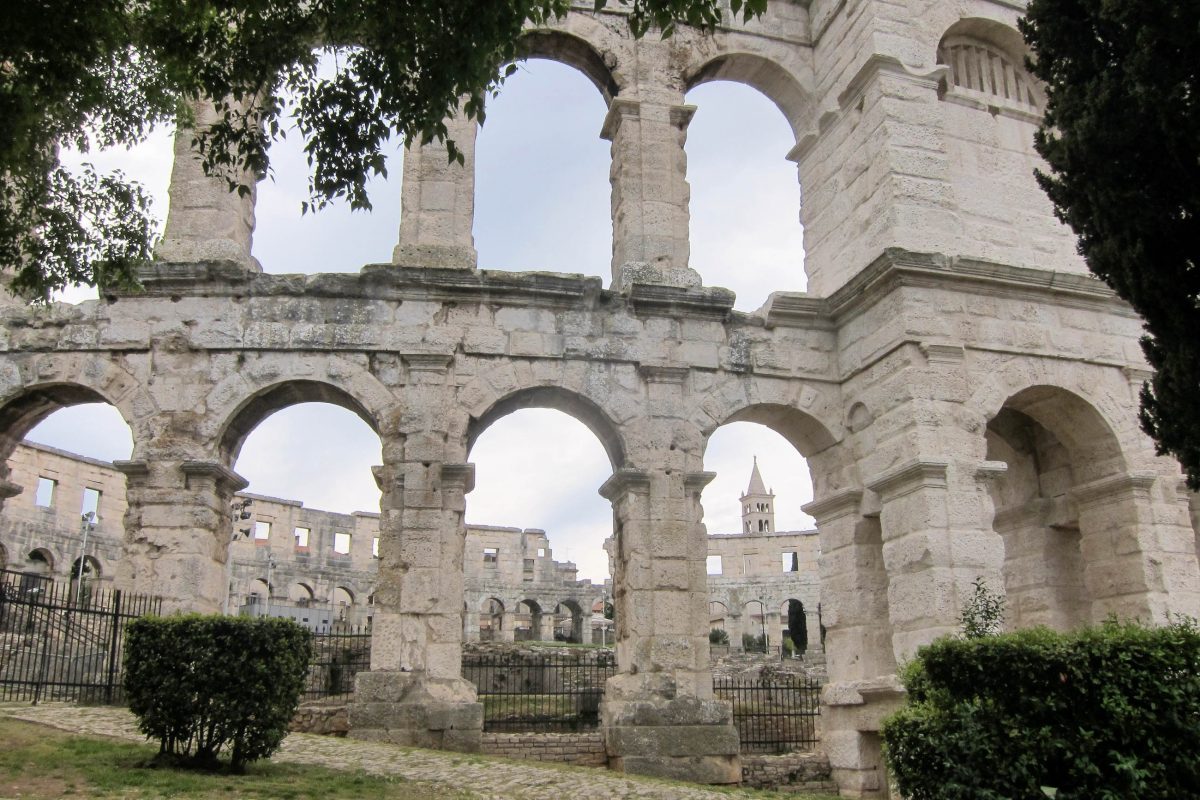
Das Amphitheater in Pula ist nicht nur die wichtigste Sehenswürdigkeit, sondern auch das Wahrzeichen der kroatischen Hafenstadt in Istrien. Die „Arena“, wie das Amphitheater von Pula auch genannt wird, liegt außerhalb der Altstadtmauer und zählt mit einem Oval von 132 mal 105 Metern zu den größten Amphitheatern der Welt. Die eindrucksvollen Mauern bestehen aus 72 Arkadenbögen aus weißem Kalkstein und erreichen eine Höhe von gut 32 Metern. 23.000 Zuschauer fanden damals hier Platz.
BILDER: Amphitheater in Pula
Fotogalerie: Amphitheater in Pula
Entstehung des Amphitheaters in Pula
Ursprünglich erbaut wurde das Amphitheater von Pula von 2 vor bis 14 nach Christus. Zu seiner heutigen Größe ausgebaut wurde es jedoch erst knapp 100 Jahre später unter Kaiser Vespasian, der auch das Kolosseum in Rom in Auftrag gab. Der Legende nach erfolgte die Erweiterung für eine Geliebte des Kaisers, die aus Pula stammte.
Pula Film-Festival und Konzerte
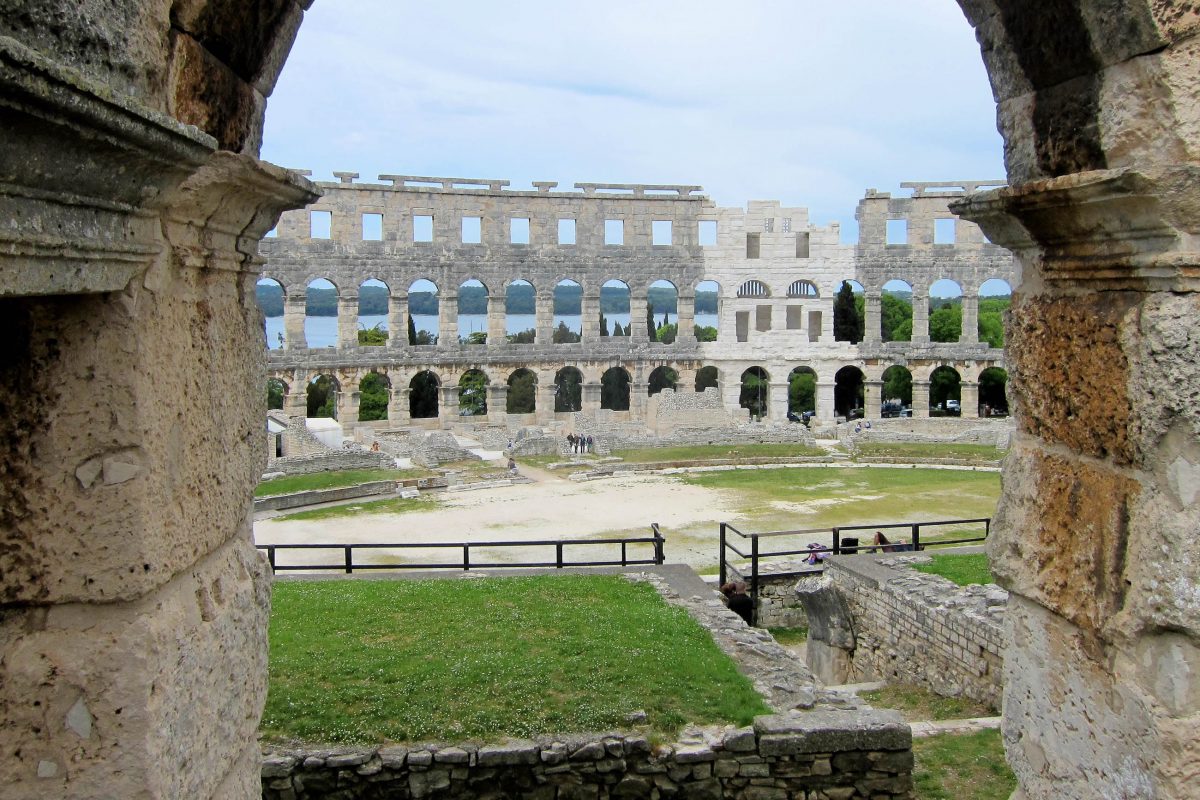
Früher wurde das Amphitheater für Gladiatorenkämpfe und Seeschlachten verwendet, heute finden in der 68 mal 42 Meter großen Arena Konzerte und das Pula Filmfestival statt, eines der ältesten Filmfestivals der Welt. Jeden Sommer werden unter freiem Himmel sowohl kroatische als auch internationale Filme präsentiert, die tausende Besucher anlocken. Dank der atemberaubenden Kulisse ist das Festival eine der attraktivsten Open-Air-Veranstaltungen der Welt.
Auch klassische Konzerte und Rock-Konzerte finden im Amphitheater von Pula statt. Dank der fantastischen Akustik des Amphitheaters waren bereits Musikgrößen wie Sting, Julio Iglesias, Elton John, Norah Jones, Alanis Morissette oder Luciano Pavarotti in Pula zu Gast.
Öl- und Weinbau-Museum
Im Untergeschoß des Amphitheaters, wo einst Gladiatoren und wilde Tiere auf ihre Auftritte warteten, ist heute in Museum eingerichtet, welches sich mit der Geschichte des Weinbaus zu Zeiten der Römer befasst. Die antiken Amphoren in den Katakomben des Amphitheaters enthielten einst Öle und feinsten kroatischen Wein.
Stadttore von Pula
Wendet man sich auf der Amfiteatarska Ulica in Richtung Süden, erreicht man nach wenigen Metern die ehemalige Stadtmauer von Pula mit dem mächtigen Stadttor Porta Gemina aus dem 2. Jahrhundert, hinter dem das Archäologische Museum Istriens liegt.
Gleich daneben folgt mit dem eher schlichten Herkules-Tor aus dem 1. Jahrhundert das nächste Stadttor im historischen Mauerring. Einst gewährten zehn Tore den Zugang zur Stadt.
Triumphbogen der Sergier

Der Giardini folgend erreicht man bald den baumbestandenen Korzo Giardini, sowie das nächste Highlight von Pulas Altstadt. Der Triumphbogen der Sergier wurde um 30 vor Christus nach der Schlacht von Actium damals noch innerhalb der Stadtmauer errichtet und Sergius Lucius, dem Tribunen der 29. Legion, gewidmet.
Wohnhaus von James Joyce
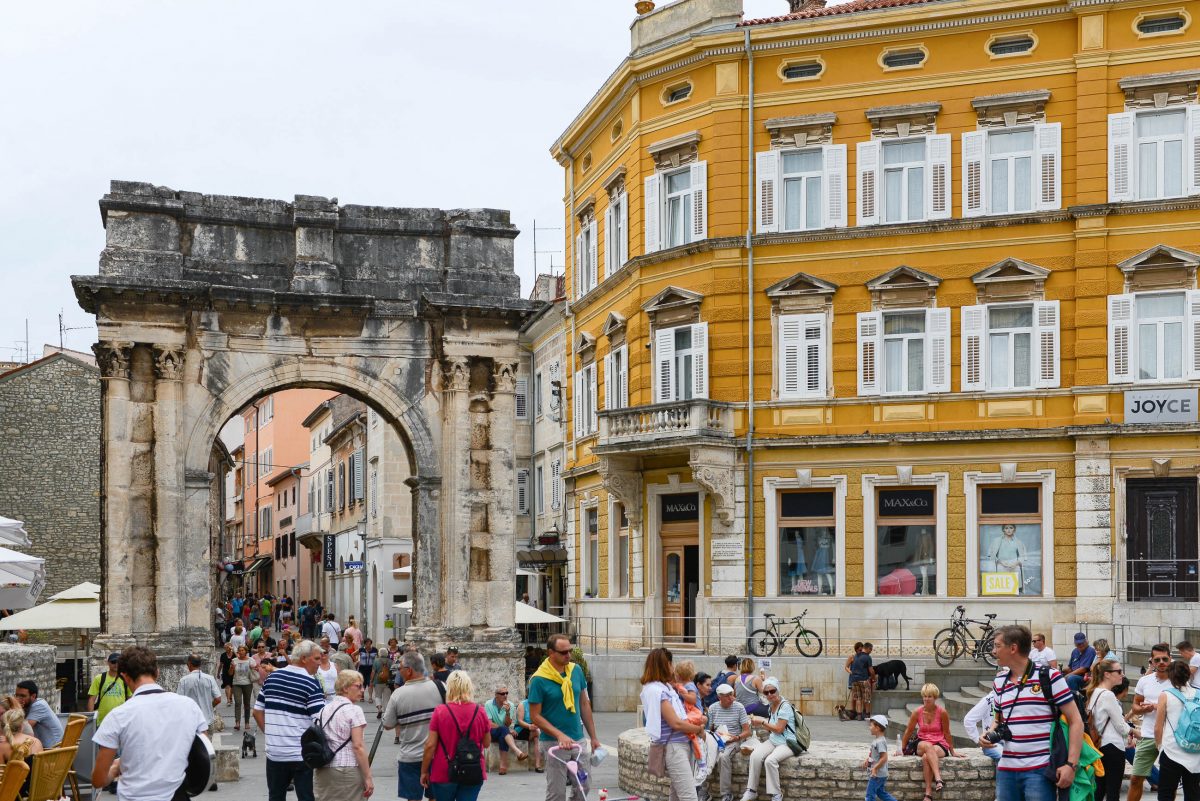
Das Haus rechts daneben beherbergte 1904 bis 1905 den irischen Schriftsteller James Joyce, der damals im Alter von 23 Jahren als Englisch-Lehrer in Pula lebte. Ein Bronze-Denkmal vor dem Café Uliks erinnert heute noch an seinen Aufenthalt.
Grünmarkt auf dem Narodni trg
Wendet man sich auf der Anticova Ulica nach links erreicht man den umfangreichen Grünmarkt auf dem Narodni trg. Dieser bietet mit frischen Produkten aus dem Hinterland, Imbissständen, netten Cafés und einer historischen Markthalle aus dem Jahr 1903 sowohl kulinarische als auch historische Sehenswürdigkeiten.
Mit seinem Angebot an Bananen, Feigen, Honig, Käse, Fisch und Fleisch gilt der Grünmarkt von Pula als einer der schönsten und günstigsten der Region.
Kapelle Marije Formoze
Wieder retour mündet die Anticova Ulica in die stark befahrene Uferstraße Flaciusova Ulica, an der die Kapelle Marije Formoze liegt. Sie ist der klägliche Überrest der einst stattlichen frühbyzantinischen Basilika Santa Maria Formosa aus dem 6. Jahrhundert.
Römisches Forum
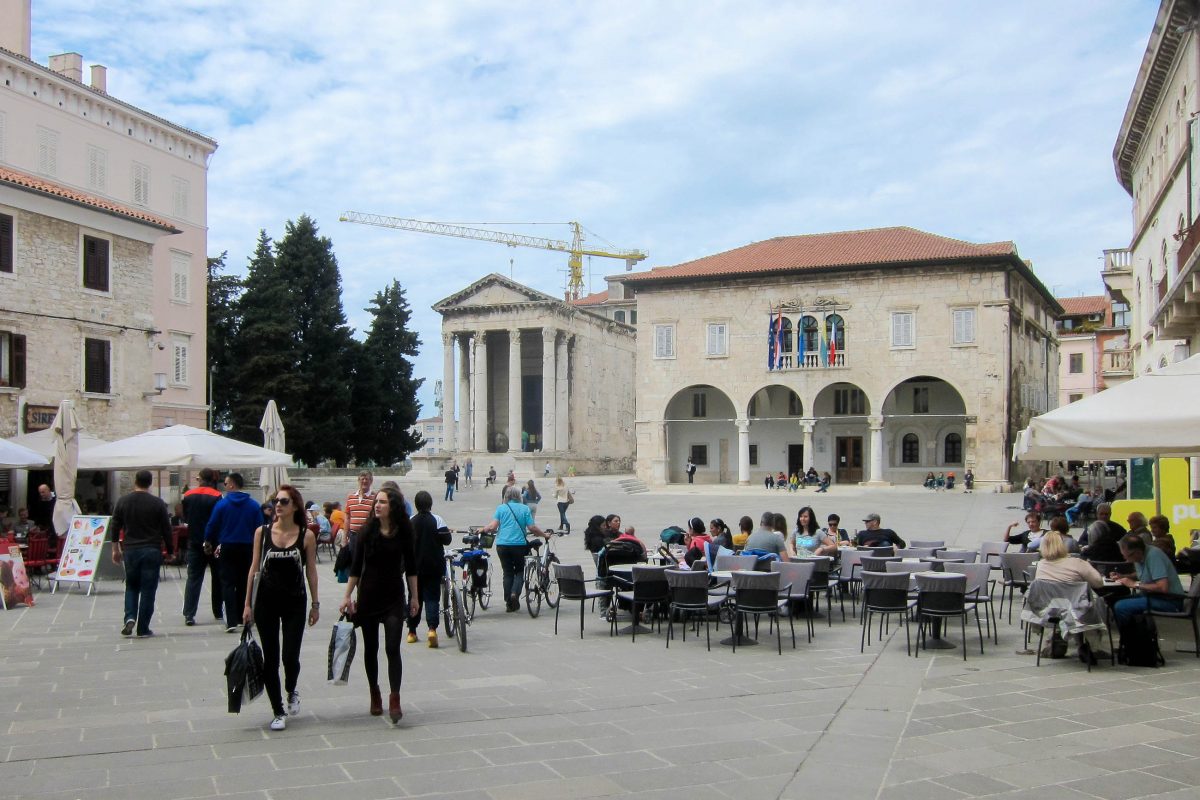
In der Biegung von der Flaciusova Ulica in die Küstenstraße Riva liegt das Römische Forum, der Trg Kapitolinski, der mit seinen zahlreichen antiken Bauten und einladenden Cafés ein ganz besonderes Ambiente verströmt.
Das bemerkenswerteste Gebäude am heutigen Kapitolsplatz ist der Tempel der Roma und des Augustus. Der Tempel, dem seine acht Meter hohen korinthischen Säulen besondere Eleganz verleihen, wurde um 14 nach Christus vollendet und ist dank der spätantiken Umwandlung in eine Kirche bis heute ausgezeichnet erhalten. In seinem Inneren können römische Skulpturen besichtigt werden.
Ebenfalls am Forum gleich neben dem Augustus-Tempel thront mit einer hübschen Arkadenvorhalle das venezianische Rathaus von Pula, welches 1296 erbaut wurde. An seiner Rückseite sind die Überreste zweier weiterer antiker Bauten, des Diana-Tempels und des Kapitolstempels, zu erkennen.
Ulica Sergijevaca
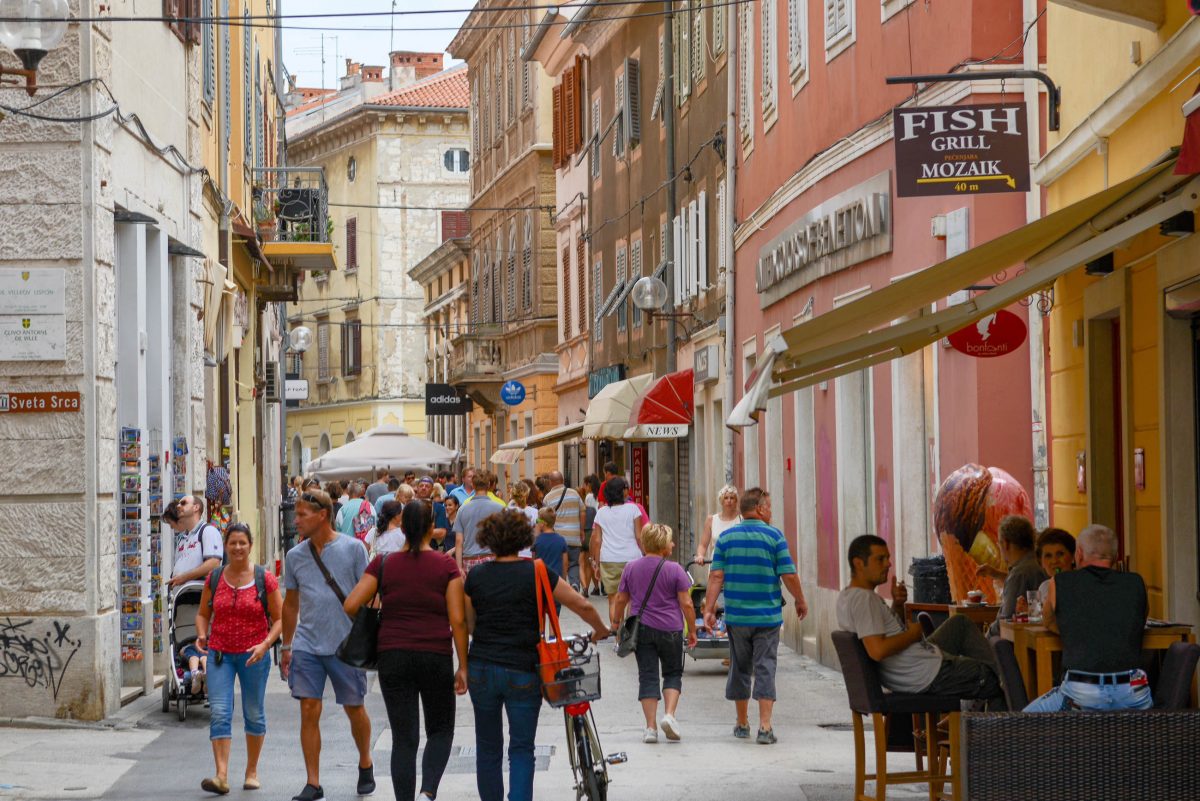
Vom Forum direkt zurück zum Triumphbogen der Sergier führt die sehenswerte Flaniermeile Ulica Sergijevaca, die von internationalen Handelsketten, Fastfood-Restaurants und historischen Fassaden gesäumt wird.
Mosaik „Bestrafung der Dirke“
Die erste Straße rechts nach dem Forum führt zu einem Gebäude mit einem komplett erhaltenen Römischen Bodenmosaik aus dem 3. Jahrhundert, welches auf einer Fläche von 12 mal 6 Metern die äußerst seltene mythologische Erzählung „Bestrafung der Dirke“ zeigt (sie wurde von einem Stier zu Tode geschleift, nachdem sie ihre Nichte Antiope eingesperrt und gequält hatte). Es wurde zufällig unter dem Schutt entdeckt, den die Bombenangriffe im Zweiten Weltkrieg zurückgelassen haben.
Franziskanerkirche Sveti Franje

Über die erste Straße links gelangt man zur frühgotischen Franziskanerkirche Sveti Franje aus dem 13./14. Jahrhundert. Sie beeindruckt vor allem durch ihr romanisch-gotisches Eingangsportal und ihren schönen Kreuzgang. Vorbei an der Kirche Sveti Franje geht es weiter nach oben auf den Hügel bis zum Kastell.
Kastell von Pula
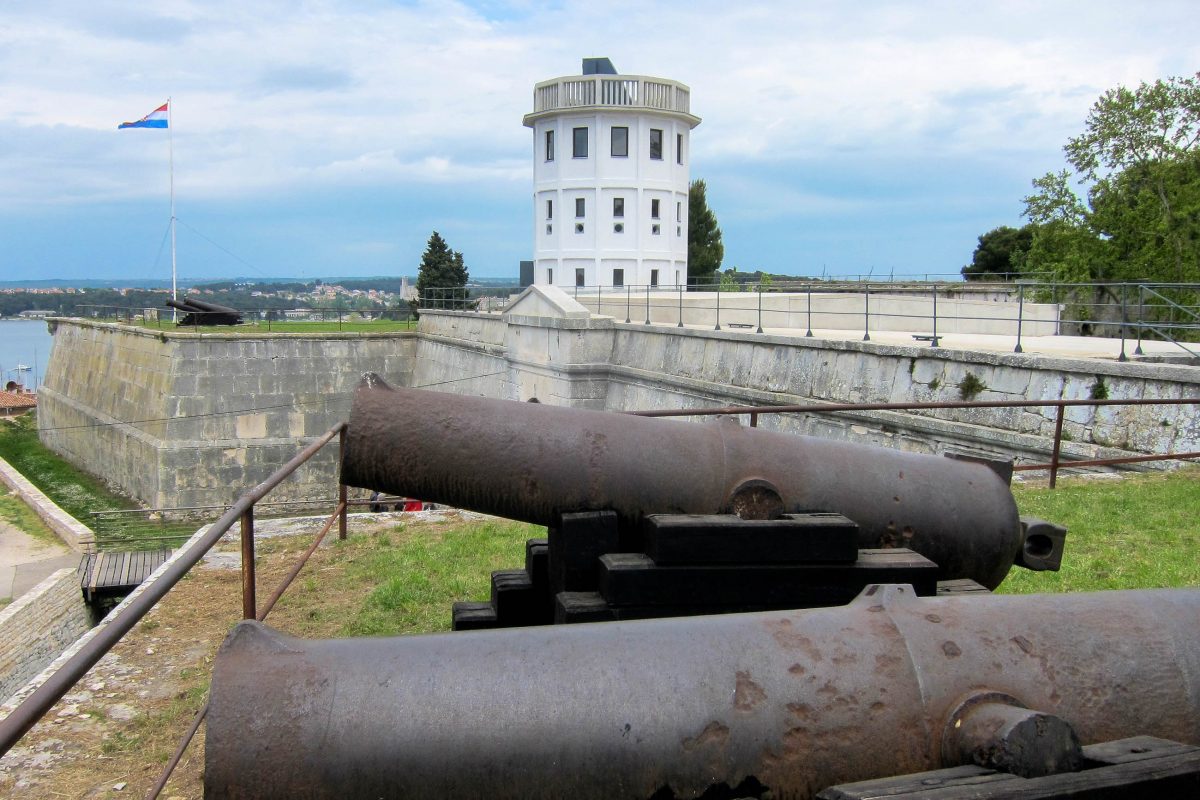
Die imposante Festung liegt auf dem höchsten Hügel von Pula gut 30 Meter über dem Meeresspiegel. Sie stammt aus dem Jahr 1632, als die Venezianer über die Region herrschten. Bereits zuvor befanden sich auf dem Hügel eine istrische Burg und einige frühchristliche Kirchen.
Erbauer der Festung war der französische Militär-Architekt Antoine de Ville, der die neuesten Erkenntnisse der französischen Festungsbaukunst bis ins venezianische Pola mitbrachte. Das eindrucksvolle steinerne Bollwerk wird von vier eckigen Bastionen eingegrenzt und bietet von seinen Wehrmauern einen herrlichen Rundblick über die Altstadt von Pula.
BILDER: Kastell von Pula
Museum der Geschichte Istriens
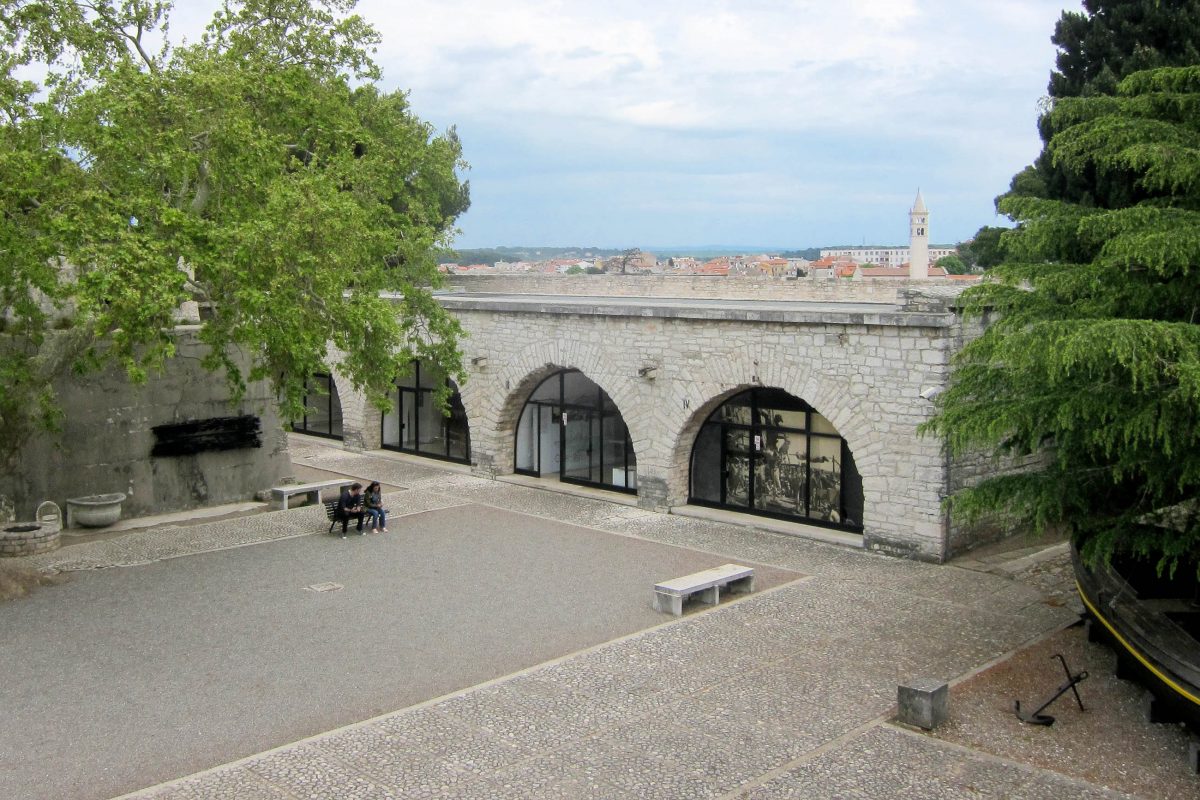
Neben den altehrwürdigen Mauern ist im Kastell von Pula auch das Museum der Geschichte Istriens mit über 40.000 Ausstellungsstücken zu besichtigen. Sowohl die Ausstellungs- als auch die Arbeitsräumlichkeiten befinden sich in der ehemals venezianischen Festung. Das Museum wurde am 31. Dezember 1955 gegründet und hieß damals noch „Museum der Revolution“.
Das Museo Storico dell’Istria präsentiert in drei Abteilungen das Erbe Pulas und Istriens vom Mittelalter bis zur Neuzeit und beschäftigt sich vor allem mit der Vergangenheit des regionalen Schiffbaus und dem Militär in der k.u.k-Zeit. Zu sehen sind Objekte aus dem Stadtleben, historische Fotografien, Filmaufnahmen und Ansichtskarten, Sammlungen von Orden, Urkunden, Stempel, Münzen, Uniformen, Landkarten, Waffen und Wappen.
Kathedrale Maria Himmelfahrt

Wer sich beim Abstieg vom Festungshügel rechts hält, erreicht an der malerischen Riva die Kathedrale Maria Himmelfahrt. Die schmucke Kirche mit dem freistehenden Glockenturm wurde bereits im 5. Jahrhundert begonnen und bis zu ihrer Vollendung im Jahr 1707 immer wieder erweitert.
Zuvor befanden sich an ihrem Standort ein Jupiter-Tempel und danach eine Basilika. Im Inneren der Marien-Kathedrale ist vor allem der Kontrast zwischen den spätantiken Fenstern im Mittelschiff und den gotischen Fenstern in den beiden Seitenschiffen bemerkenswert. Hinter der Kathedrale führt die Kandlerova Ulica wieder zum Amphitheater, dem Ausgangspunkt des Rundgangs.
BILDER: Altstadt von Pula
Fotogalerie: Altstadt von Pula
Weiterführende Links:
Offizielle Website von Pula
Offizielle Website des Pula Filmfestivals

